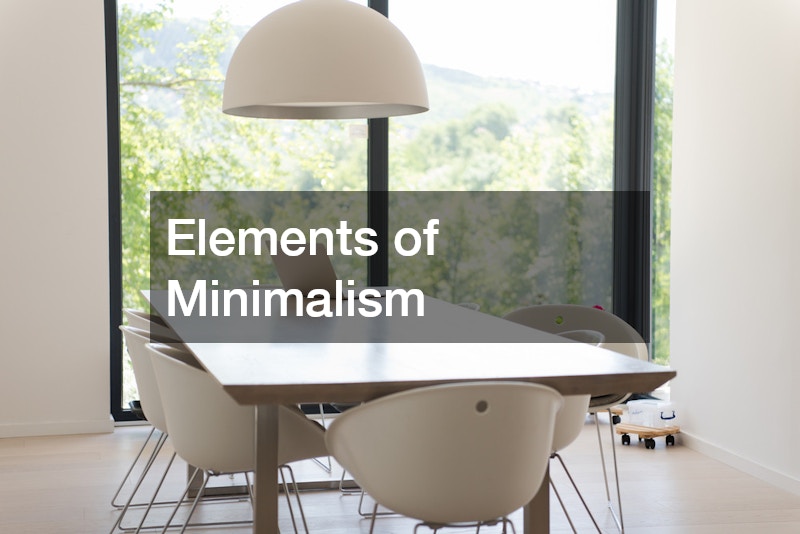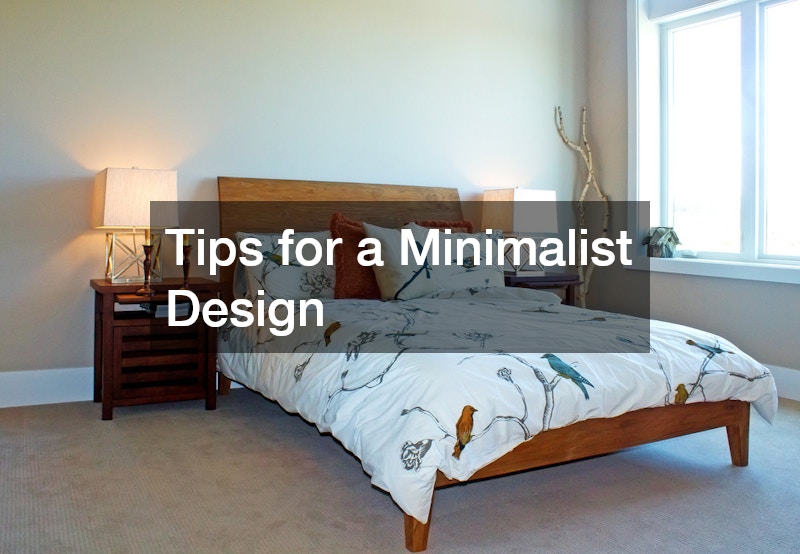In a world awash with excess and cluttered surfaces, minimalism is a refreshing alternative. This design philosophy will transform your home into a tranquil sanctuary with clean lines, uncluttered areas, and a calm atmosphere. How can one achieve this aesthetic while maintaining functionality and comfort? Explore the elements of minimalism to learn how you can create a simple but impactful design.
Elements of Minimalism

1. Simplicity
Simplicity is the essence of minimalism. It means clearing your space of clutter and reducing it to the essentials. Each piece of decor and furniture should have a specific purpose and add to the harmony of the space. Simplicity is often associated with a neat and organized room where each item has its own place and purpose.
Start by evaluating each item’s function and necessity. Get rid of anything that does not serve a purpose or bring you joy. It doesn’t mean living without things; instead, you should choose items that will add value to your daily life. This will result in a home that is easy to maintain and free of unnecessary distractions.
2. Clean Lines
In minimalist design, clean lines are paramount. This design style is characterized by sleek, straight lines and avoids ornate details. Furniture with geometric shapes and streamlined profiles enhances the visual order in the room. Clean lines enhance the architectural features of a space and give even the smallest of rooms a sense of spaciousness.
Choose furniture and decor that embodies simplicity and clarity. This will contribute to the minimalist aesthetic. Integrating hardwood can enhance clean lines as the grain and texture on hardwood surfaces add refinement and elegance to the space.
3. Neutral Color Palette
A neutral color palette is the most popular in minimalist design. It often features shades like beige, white, gray, and black. These calm tones create a tranquil backdrop that allows essential design elements to be the focus of attention without overwhelming the room. Neutral colors are adaptable and calm, creating a timeless base that can easily be refreshed with accents or accessories.
It’s important to consider the amount of natural light in your home when choosing colors. Light grays and soft whites can enhance brightness, while darker neutrals like charcoal and taupe add depth and elegance. It is important to achieve a palette that flows seamlessly from one room into another. A professional painter can help you achieve the desired look by applying each color with precision. Their expert execution ensures a harmonious and unified aesthetic in your minimalist space.
4. Functional Furniture
Furniture pieces should not only be aesthetically pleasing but also have a functional purpose. To maximize your space, look for furniture that can be used in multiple ways and has hidden storage. Each piece of furniture in a minimalist house should serve two purposes: a sofa that can be converted into a bed, an ottoman that has storage, or a table with a desk.
Functional furniture can help you keep your home clutter-free and organized. This ensures your space is versatile and can be adapted to suit different activities and needs. The look and function of your home can be significantly improved by investing in well-designed, high-quality furniture. Furniture stores have a wide range of choices to suit different minimalist design tastes and requirements. These establishments offer a wide range of furniture that seamlessly blends form and function.
5. Quality Over Quantity
In a minimalist house, quality always wins over quantity. Select durable furniture and decor items over cheap disposables. Quality items are not only more attractive but last longer. This reduces the need to replace them frequently and contributes to a sustainable lifestyle.
Consider the quality of the materials and workmanship when choosing items for your house. Choose timeless designs that will never go out of fashion and can easily be incorporated into different settings. The building supply stores have a wide range of products that are carefully curated to last the test of time. Focusing on quality will create a home that is filled with cherished, meaningful items rather than a collection of temporary, disposable pieces.
6. Empty Space
Incorporate the idea of negative or empty space into your design. Uncluttering your home will create a feeling of calm and tranquility. Empty spaces are a key element in minimalist design. They create a contrast which highlights the beauty and function of the pieces you include.
Resist the urge to cover every corner or wall. Focus on harmony and balance instead. Empty space can be used to highlight key features such as an art piece or unique furniture. This not only improves the aesthetics of your home but also makes it more enjoyable to live in. Integrate frameless glass doors into your living area to seamlessly blend indoor and outdoor environments. This will allow natural light to flood in while creating an airy feeling.
Tips for a Minimalist Design

Implementing strategic tips in the pursuit of minimalistic design perfection can elevate the ambiance of your home and its functionality.
1. Regularly Declutter
Decluttering is the first step in your minimalist journey. By systematically removing things that don’t serve a function or bring you joy, take proactive steps to streamline your environment. By removing all but the essentials, you can create a home that is simple and clear.
Establish a routine to declutter your home, whether you do it monthly, annually, or on a seasonal basis. You can also hire professional cleaning services to help you with this process. Adopting the “one out, one in” rule will also help you to cultivate a conscious approach to consumption. This will reinforce your commitment to minimalism and promote sustainability.
2. Streamline Your Decor
Less is more when it comes to decorating. Select a few key items that you love and compliment the aesthetics of your room. Avoid cluttering surfaces and shelves with small items. Opt for elegant, simple decorations to enhance the minimalist feel.
Select decor items with a clear purpose or significance. You could choose a vase, a photo, or an artwork. You can create a space with thoughtful decor that is meaningful and intentional rather than cluttered or overwhelming.
3. Invest in Quality Storage Solutions
For a minimalist house, effective storage is key. To keep clutter away, invest in stylish storage options such as modular shelving, sleek cabinets and hidden storage ottomans. Storage that is well-designed not only organizes your items, but also improves the look and feel of any space.
Built-in storage can be a great option for your home. Under-bed storage, custom closets, and built-in shelves can offer ample space to store your belongings and maintain a neat and tidy appearance. Custom cabinet services can create stylish bookshelves or closets that maximize space while maintaining style. Transparent storage containers and labels will help you organize your belongings.
4. Focus on Lighting
Lighting can add to the minimalist look of your home. When possible, opt for natural lighting and combine it with ambient light fixtures like recessed lights or hanging lamps. Avoid ornate lighting fixtures that take away from the simplicity of your space.
To create a warm, inviting atmosphere, layer your lighting. Combine general, accent, and task lighting to add depth and dimension to your home’s design. Dimmable lights allow you to change the brightness depending on the time of the day and the mood you wish to create.
5. Embrace Texture
Texture can be used to add visual interest and depth to your home. Consider adding tactile elements like wool rugs or linen curtains. You can also add natural wood accents. Texture can add warmth and character without overwhelming a minimalist room.
Try experimenting with different finishes and materials to create a layered and rich look. A soft throw of wool can be used to add comfort to an elegant leather sofa. A textured ceramic vase will bring a touch of craftsmanship to any shelf. Explore the tactile richness in ceramic or stone tile to add textural depth to your minimalist design palette. To ensure your space is sophisticated while still maintaining its minimalist appeal, shop at reputable tile shops. It is important to balance textures in a way that enhances your overall aesthetic.
6. Create Zen Zones
Zen zones are areas in your home where you can relax and unwind. To promote relaxation, keep these areas clutter-free. Include elements like comfortable seating, soft lighting, and soothing colors. Zen zones are as simple as a reading nook or meditation corner.
Focus on comfort and simplicity to create a Zen zone. Select calming colors like soft greens and blues and use natural materials such as wood and stone. You can make your space more inviting by adding personal touches like a favorite artwork or book. Create a place where you can find peace and tranquility and escape the daily stresses.
7. Greenery is a Great Way to Bring in the Spring
Plants can bring life to your minimalist space and help you create a connection with the outdoors. Low-maintenance indoor plants like succulents and snake plants are ideal. They require little care. The addition of greenery to your home will enhance the feeling of serenity and calm.
Consider the size, color, and shape of plants when selecting them. Choose varieties that fit your design and complement it. Use elegant, simple planters to blend in seamlessly with your décor. Group plants together for a cohesive appearance and to maximize their visual impact.
8. Multipurpose Furniture is a Good Choice
Every piece of furniture in a minimalist house should be able to serve two purposes whenever possible. To maximize functionality, look for furniture that can be used in multiple ways, such as ottomans, nesting tables, or sofa beds. Multipurpose furniture can help you save space while keeping your home well organized.
Prioritize durability and quality when choosing multipurpose furniture. Choose pieces that are durable and well-built. Consider investing in carefully selected living room sets if you are looking for versatile options that will seamlessly fit into your space. These sets are often composed of coordinated pieces that have been designed for both aesthetics as well as functionality. This ensures a harmonious and efficient layout in your minimalist home.
9. Keep your entryway clutter-free
It is important to keep your entryway clutter-free. To create a welcoming and tidy entrance, invest in stylish storage benches or wall-mounted racks for shoes, bags, and outerwear. An organized entryway creates a good first impression and keeps the rest of your house clutter-free.
To maximize your space and hide clutter, consider incorporating built-in storage solutions such as a closet, mudroom, or pantry. Furniture that offers both storage and seating is ideal, like a storage bench or hall tree with shelves and hooks. You can make the most out of your limited space and still maintain a neat, organized entryway.
Consider upgrading your entryway door by hiring a reputable company to help you. This will enhance its functionality and appearance. Well-designed entry doors that are properly installed not only enhance the curb appeal of your house but also improve security. You can choose from a variety of options, including sleek and modern styles to classics that have stood the test of time. This will help you create an inviting first impression on visitors.
10. Visual Restraint
Visual restraint in minimalist design is essential to creating a harmonious and serene space. This principle promotes simplicity and moderation when it comes to decor, promoting clean lines, minimal ornamentation, and a consistent color palette.
Visual restraint is achieved by choosing simple monochromatic fabrics and using negative space. You can achieve a minimalist aesthetic by carefully curating design elements, embracing the less-is-more approach, and adopting a balanced, cohesive, and visually pleasing approach.
Conclusion
To achieve a minimalist style, you must carefully consider the following elements: simplicity, clean lines and neutral colors, functional furniture, value over quantity, quality, and empty spaces. You can achieve a harmonious and serene living space by following these principles and using practical tips to achieve minimalist design. Let your home reflect your values and priorities.
